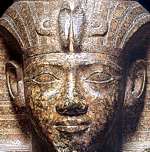|
XXVth dynastia 740 - 656 |
||
|
For events
in Nubia between the end of the New Kingdom and the early eighth century BC,
evidence is extremely meagre. Although the suggestion that Lower Nubia was
depopulated during this period is probably an exaggeration, the population may
have been less prosperous than in earlier times and perhaps reverted to a
semi-nomadic economy or migrated to the more prosperous south. Sporadic
references to viceroys of Kush during XXIst-XXIIIrd
Dynasties indicate that some Egyptian pretensions to authority there were
maintained, and elements of royal titularies and formal epithets from temple
inscriptions in Egypt have been adduced as supportive evidence for an aggressive
policy to regain Upper Nubia - but, if this were the case, there was no lasting
effect. By the mid-eighth century the chieftains of Napata, the
centre of the cult of Amun in Nubia, had become overlords of Nubia and were
already entertaining pretensions to rule Egypt as well.
The office of Divine
Adoratrise of Amun becomes more and
more important and royal daughters and sisters at Theban throne hold rule
equally powerful as royal power. |
||


 S
S P
P